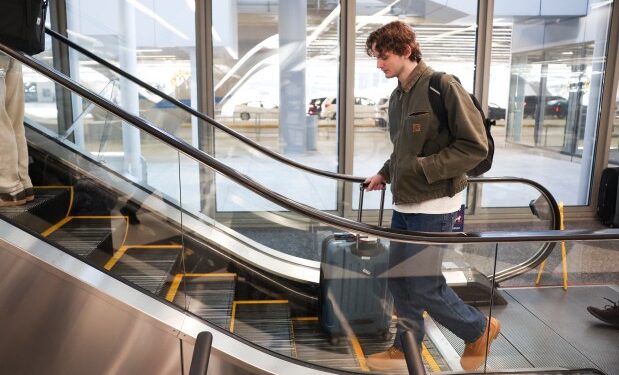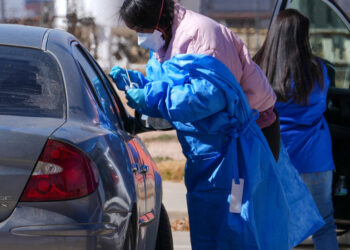Danielle Ryan woke up from her nap on Tuesday around 11 a.m. to multiple missed calls and messages from loved ones telling her to get out of her home in the Pacific Palisades. It was not until the Chicago native opened her blinds and saw orange smoke erupting close to where she lived when she finally understood why.
With very little time, Ryan grabbed a few essential items — her passport, computer, medication, dog food and dog — and drove off to a friend’s house in Calabasas. She initially started driving north on Sunset Boulevard only to find the area backed up with cars, so she turned around and started going south, passing pedestrians helping others trying to escape.
“I’m just trying to just stay calm, stay focused, drive, get out of there,” Ryan said. “But just out my rearview mirror, I’m seeing just the smoke around all the fires.”
Although she was aware of how dangerous wildfires could be in California, Ryan – who moved to LA last year – said this was the first time she truly understood the devastation that can be caused by a fire.
“I’m so naive,” Ryan, 31, said. “I just didn’t know how fast things could spread.”
Ryan was among the estimated 180,000 people forced to flee their homes this week as firefighters battle to control a series of major fires in the Los Angeles area that have killed at least five people and ravaged communities from the Pacific Coast to Pasadena. The first fire ignited Tuesday morning in the Pacific Palisades neighborhood.
On Thursday, former Chicago mayor Lori Lightfoot shared on X that her aunt and uncle, who had lived in Altadena for more than 60 years, had “lost literally everything,” and urged for prayers.
The Palisades Fire has so far burned over 17,200 acres, according to the California Department of Forestry and Fire Protection website, while the Eaton Fire, located near Pasadena, has burned 13,600 acres. Firefighters have yet to contain the Palisades and Eaton Fires.
Other smaller fires in the county, such as Hurst Fire and the Lidia Fire, have been partially contained and the Sunset Fires and Woodley Fires have both been fully contained.
The cause of ignition has still yet to be determined, but dried vegetation combined with unusually strong Santa Ana wind speeds of up to 100 mph contributed to the fires’ growth. With 2024 set to be the hottest year on record for the globe, increased temperatures mean more dried-out, flammable vegetation. And that vegetation, combined with unusually strong Santa Ana wind speeds, means more unpredictable fires that can spread quickly and are difficult to put out.
Many of those interviewed by the Tribune described the fires being on a scale unlike anything they had ever experienced or seen, with thousands of structures destroyed.
“If you’re from LA, you’re used to it … You have a little bit of brush fire in your DNA. It’s the same way you have LA traffic in your DNA,” said Alexia Palomino, a Ph.D. student at the University of Illinois Chicago conducting fieldwork in Los Angeles. “But this was a whole different beast.”
Palomino, who was born and raised in Los Angeles, said she never thought she would have to evacuate her home in Altadena due to a fire.
“We live below a fire line,” said Palomino, whose family has lived in Altadena since the 1960s. “In my life, and in the life of my mom and my parents, my family who’s been there, fires have never jumped below the fire line.”
Experts say that conditions exacerbated by climate change are being felt across the globe, with more places seeing droughts and extended heatwaves. Fires in the Western United States are now more commonplace, and the entire country sees “some number of fire weather days on average,” said Kaitlyn Trudeau, a senior research associate with Climate Central.
“It’s getting really hard to kind of predict the future, because things are changing so quickly, and things are really kind of deviating out of the bounds of what we’ve known,” Trudeau said.
Although Chicago is unlikely to feel the effects of the fire, smoke from wildfires spread to other parts of the country, creating serious health risks and further contributing to pollution, as what happened in Illinois in 2023 when a major fire burned through Canada.
Palomino said when she got the order to evacuate Wednesday around 3 a.m., she could smell smoke inside her house as she grabbed her work computer, passport and medication.
Several hours later, her brother Carlos went to check on the house and found it completely destroyed — as well as nearly every other house in her neighborhood.
“I’m a third-generation Altadenan,” Palomino said. “I love that town. I love that neighborhood. It’s beautiful. It’s full of people who care about each other … and that’s why it’s even more horrific that this happened.”
She and her family plan to rebuild their home; a graduate student at her university set up a GoFundMe page to help.
While Ryan is unsure whether her studio apartment is still intact, the school she was supposed to start teaching at next Monday — Palisades Charter High School — has been badly damaged. Ryan previously worked as a special education teacher for Mount Vernon Elementary School in the South Side’s Washington Heights neighborhood and was excited for her fresh start in Los Angeles.
“The reason I moved out here was to be closer to the hiking and the weather and the sun,” Ryan said. Now, many of those hiking trails have been damaged, including some trails with historic buildings.

At O’Hare International Airport on Thursday, Jack Butcher, a 20-year-old UCLA junior from Lincoln Park, told the Tribune his dad had directed him to come home.
Butcher said many of his friends were scared and had fled. A thick orange smog had emerged across Los Angeles, Butcher said, and it smelled like fire.
“The evacuation zone was approaching where UCLA is, and so I thought it would be better to get out early just in case it kept spreading,” he said while waiting to collect his bags in Terminal 1. “Because the containment is still nonexistent.”
Stacy Jones, a member of the alternative rock band Letters to Cleo, also flew into O’Hare on Thursday. He said he woke up at home in the Los Angeles neighborhood of Atwater Village on Wednesday and saw “chaos” out the window.
“Trees were down and the sky was orange and giant pieces of ash were falling in our yard,” the 54-year-old said.
Jones was on his way to Madison, Wisconsin, with his wife and son for a Thursday night gig. He aimed to leave home on Wednesday but canceled his original plans because of the major fires. Jones said he didn’t know what was going on and wanted to take stock of the situation before departing.
On Wednesday, the smoke got so bad in his neighborhood that Jones decided to spend the night in a hotel near Los Angeles International Airport. The family hopped on a Thursday 7 a.m. flight to Chicago so they wouldn’t have to deal with the uncertainty of a connection; they rented a car to drive to Madison.

Jones, who has lived in Los Angeles for two decades, said the city is used to having fires. But these fires feel different, he said, because they’re so widespread and destructive. Jones knows many who have lost “everything” in the last 24 hours.
“There’s a neighborhood up by us called Altadena. (My son) goes to hiking camp up there, so we’re there all the time,” Jones said. “And it’s devastated. It’s gone.”
The Illinois region of the American Red Cross is in the process of mobilizing local volunteers to help people impacted, said spokesperson Connie Esparza in an email.
Hundreds of Red Cross workers were helping those fleeing, Esparza said. The Red Cross was moving truckloads of supplies “like cots, blankets and water to be ready to support thousands of additional people in emergency shelters if needed,” Esparza said.
A Salvation Army spokesperson said Thursday the Salvation Army had been deployed to serve meals and offer emotional care at Red Cross evacuation shelters in three California locations. Financial donations can be made at redcross.org.
The Los Angeles Fire Department Foundation was also actively seeking funds to equip firefighters battling the wildfires. According to the Los Angeles Times, an online donation to the California Fire Foundation Wildfire and Disaster Relief Fund directly supports victims of wildfires and disasters throughout the state.
While the devastation of the fires have been unimaginable, Ryan is thankful for all the volunteers and firefighters who are working hard to help others.
“I remember Mr. Rogers, I think his mom gave him a quote that said, ‘Always look for the helpers, and always see.’ So I was trying to look around yesterday and … I saw a pedestrian stopping traffic and getting all the people off the hill and things like that,” Ryan said. “So there are always good people trying to help.”
Stacey Stein Kovoloff, 54, recently moved back to Chicago after spending nearly 40 years in California. Living in snowy Chicago while she watched the area she spent so much of her life in burn, she said, felt like living in two different worlds.
“I feel guilty. I feel helpless,” Stein Kovoloff said. “I have a lot of friends that are looking for places to stay the night, people with young children.”
She estimates that at least 60 people she knows have been affected, including her children. Many places that were also familiar to her in Los Angeles — like the skate shop her friend owned in the Palisades Village or the local fish restaurant off the Pacific Coast Highway — are also gone.
“It’s like the Palisades was wiped out,” Stein Kovoloff said, drawing comparisons between the destruction she witnessed from afar and the Great Chicago Fire of 1871. “I miss the trees that are burned. … I miss rose bushes that we won’t see bloom again, people’s homes that were sitting since the ’40s that had a uniqueness to them.”
The Associated Press contributed.
Originally Published:







